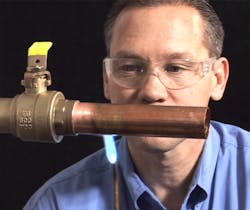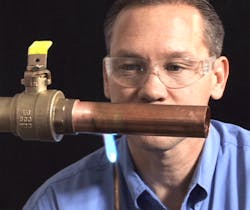WASHINGTON — A few months into the recently passed lead free legislation —which mandates that the wetted surface of every pipe, fixture, and fitting sold for or installed in potable water applications not contain more than 0.25% lead by weight — the bulk of “responsibility” has now shifted to the installing contractor.
Manufacturers converted their lines to comply pre-Jan. 4, 2014, as have the reputable wholesalers. But where do the contractors stand at this point? With the industry still in the transition, are contractors ready?
By now, most contractors are aware of the new law, but understanding is varied regarding the exact use and installation.
“Some contractors think that everything must be lead free and that leaded products are no longer applicable,” said Aaron Edds, product manager, valves, NIBCO. “The legislation only refers to drinking water systems.”
Leaded fixtures for hydronic and non-potable water systems still can be installed, and eventually the inventory of leaded fixtures for potable water systems will become non-existent.
Yet there are circles that believe some contractors may try to sidestep the new law. For example, will some techs continue to use up existing inventory by installing non-compliant fixtures?
“I am sure that many contractors are sitting on a lot of non-compliant stock that they will want to use up,” said John Baethke, Baethke and Son Plumbing, Chicago.
Funny thing. The State of Colorado, for example, is doing just that. The state is grandfathering existing leaded pipe into installations:
“As an inspection division the state plumbing inspectors will continue to look for indication that materials complying with NSF 61 are being installed as required by code. Any old stock marked NSF 61 but not carrying the new NSF 61-G will be considered code compliant and not be rejected,” reads the Memorandum from the Department of Regulatory Agencies (DORA).
“In this case, it’s a matter of letting the old product work itself out of the marketplace,” said Derek Bower, associate director of product management, metals, at Viega. “They are the only state that we are aware of that has this provision in place.”
Fuzzy interpretation
According to Edds, the industry is lagging behind regarding overall understanding of the federal legislation. “There are still engineers, contractors and distributors that do not fully grasp the intent of the law,” said Edds.
According to www.gettheleadout.com, the new standard does not apply to pipes, pipe fittings, plumbing fittings or fixtures that are used exclusively for non-potable services such as manufacturing, industrial processing, irrigation, outdoor watering, or any other uses where water is not anticipated to be used for human consumption. The law also specifically excludes toilets, bidets, urinals, fill valves, flushometer valves, tub fillers, shower valves, service saddles, or water distribution main gate valves that are 2-in. in diameter or larger.
Mark Perrone, purchasing manager for JC Cannistraro, Boston, makes big dollar purchasing decisions every day. For him, it’s not as much of an understanding of the law as it is the interpretation of it that can get a bit confusing.
“How do I prepare for a bid if there could be a differing interpretation? It makes it tough to bid on these products,” said Perrone.
Specifically, Perrone points to the issue of 2-in. main gate valves or larger. “If all valves in domestic water systems are to be lead free, why are 2-in. gate valves and larger exempt? If these are exempt, what about larger diameter shut-off valves such as 2 ½-in. and 3-in., for instance?” asked Perrone.
Local enforcement
And while we are still very early in the transition, talking about enforcement may be a bit premature. According to O’Neil, enforcement differs region to region.
“I’ve heard of a few jobs that were inspected, but I believe that the EPA understands that this is going to take time,” said O’Neil.
Although very few jobs have been inspected specifically for lead free compliance, the inspectors and certain AHJs are beginning to look for and have communicated blanket statements to comply with the new law. Nevertheless, enforcement is at the local AHJ level; however, it is varied depending upon their awareness of the law and the resources they have available to enforce it.
“The local inspectors and AHJs are going look at installations to see if they meet state requirements,” said Bower.
The goal becomes then, assuming everyone does their part to become educated, that the industry should have very few non-compliant situations.
“AHJs have a presence at the contractor and distributor level, so there is a level of enforcement already,” said Edds. “The enforcement is varied, depending on the local AHJ.”
Charles R. White, vice president, technical & code services, PHCC-National Association, concurs, saying that as far as the changes to brass, the local jurisdictions would be the ones to check for compliance with materials. In some states there may also be state inspectors that would perform this as well.
“The inspection community was involved with the training process for lead free brass and generally is aware to verify compliance with these materials,” said White.
EPA guidelines state that marking identifiers will display the certification bodies’ approved certification marks and any required identifier text, but also suggest that because markings vary between certification bodies, finding a product that has been certified as lead free to the new requirement can be a challenge — unless you know what to look for.
Soldering issues
By now, full compliance to the law should be adhered to by all involved — on a manufacturer, wholesaler and contractor level. But now there has been some talk regarding the difficulty of soldering these lead free components. According to White, feedback from around the country suggests that the soldering of lead free alloys has been more difficult than anticipated.
Some contractors thought that it was not much different than previous alloys but have found that heating times are longer and corresponding cool down times are longer, as well.
Also, the increased corrosion resistance of the newer alloys has benefits, but a side effect is some fluxes have less effectiveness causing poor penetration into the joint. Cleaning and preparation of the pipe and fitting cup must be thorough, as well.
“Technicians need to practice proper soldering techniques and be vigilant in the cleaning and preparation process to have professional results,” said White.
The Copper Development Association CDA has been instrumental in helping contractors understand the intricacies of soldering copper tube and fittings to the newer, no-lead, brass and bronze copper alloys.
“Many component manufacturers are now using new, no-lead copper alloys that use bismuth, silicon or other elements in place of lead to make their components,” said CDA vice president, Andrew Kireta Jr. “Even though these components may look the same as the older metals they are replacing, they can be a bit more difficult to solder. That’s why it’s important that we revisit these soldering techniques.”
With the help of Kireta and CDA project manager, Dale Powell, the CDA produced a video entitled Soldering of No-Lead Copper Alloy Fittings, Valves and Components, which not only demonstrates the proper soldering techniques for new alloys, but offers an explanation as to why they must be treated differently from the old ones.
“The answer lies in the metallurgy, or physical properties of the alloy,” Powell states in the video. “Some of the new alloys, especially those containing silicon, have much lower thermal conductivity than their earlier counterparts, or than the copper parts that they are being joined with.” The video can be found at www.copper.org.
Lead free resources
There are several resources available for contractors on lead free compliance. The Get the Lead Out Plumbing website is still up (www.gettheleadoutplumbing.com).
“We just added some new resources on soldering to the site,” said Cindy Sheridan, COO, PHCC Educational Foundation. “Also, we hope to offer a presentation at CONNECT 2014, Oct. 8-10 in New Orleans.”
In addition, Watts Water Technologies’ www.weareleadfree.net, an online lead free resource, is available.

